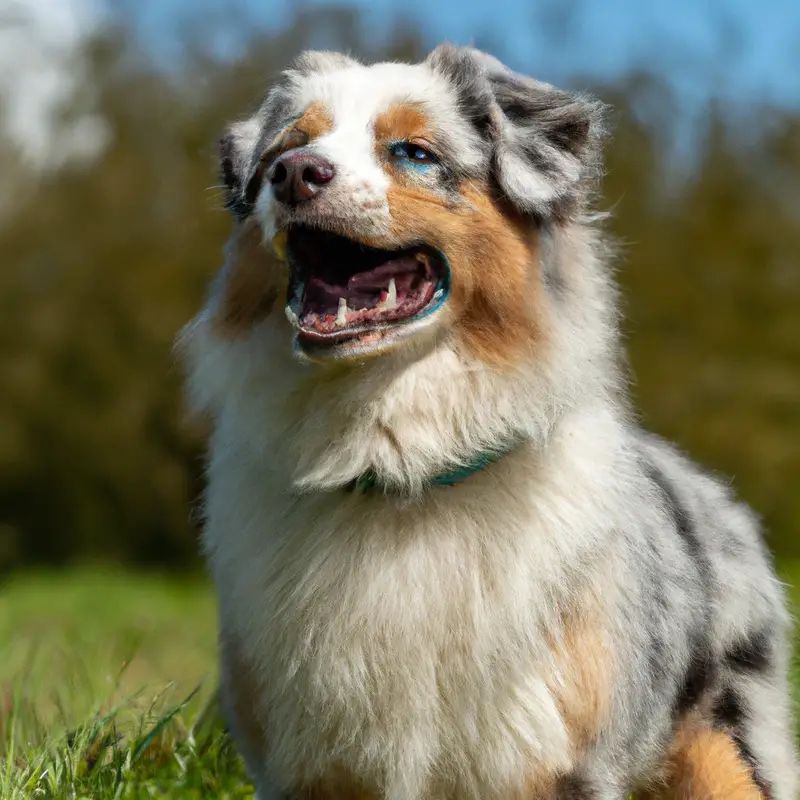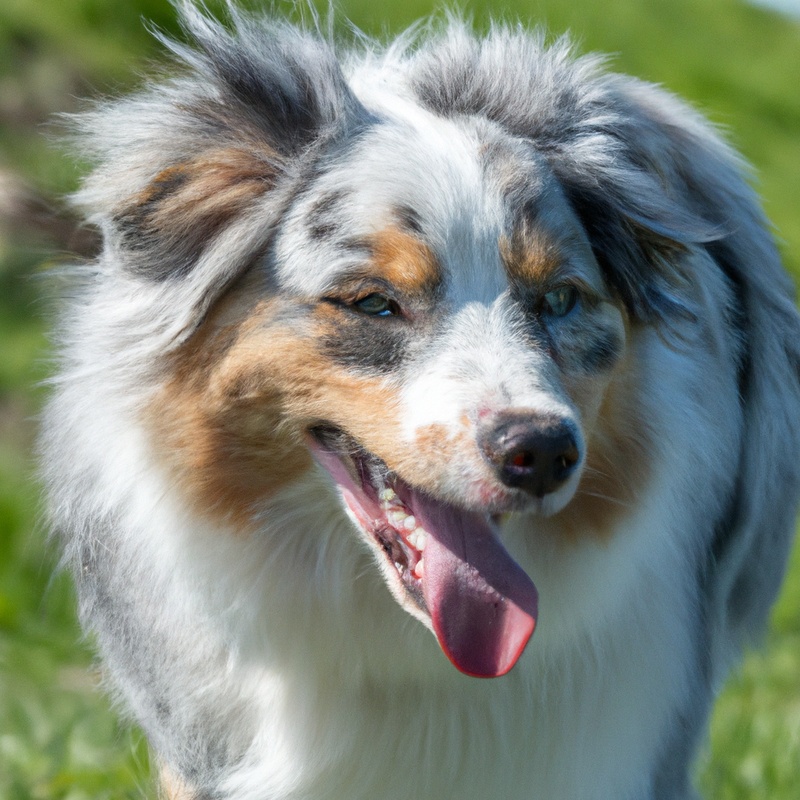How Do Australian Shepherds Behave When Introduced To New People?
Key Takeaways:
- Australian Shepherds are generally friendly and enjoy meeting new people.
- They may initially be cautious or reserved, but can warm up quickly with proper socialization.
- Proper training and early exposure to various individuals is essential for their positive behavior.
- Australian Shepherds tend to be protective of their owners, which can influence their interactions with new people.
Are you curious about how Australian Shepherds, those lovely and intelligent dogs, behave when they meet new people? Well, as an expert in canine behavior, I’m here to shed light on this fascinating topic.
Understanding the factors that influence their behavior, such as socialization, temperament, and the owner’s influence, is crucial.
In this article, I’ll explore the typical behavior of Australian Shepherds when introduced to new people, the signs of anxiety or aggression to watch out for, tips for successful introductions, and how to handle any unwanted behavior. So, grab a cup of coffee and let’s dive into the world of Aussie behavior!
| Behavior | Description |
|---|---|
| Friendly | Australian Shepherds are typically friendly and welcoming towards new people. They generally show affection and enjoy meeting and interacting with strangers. |
| Reserved | Some Australian Shepherds may be more reserved when meeting new people. They might need some time to warm up and feel comfortable before fully engaging. This behavior can vary depending on each individual dog’s personality and early socialization experiences. |
| Protective | Australian Shepherds can also display protective behavior when introduced to new people. They may be watchful and cautious, especially if they perceive a potential threat. Proper training and socialization can help mitigate any excessive protective instincts. |
| Curious | Many Australian Shepherds exhibit curious behavior when encountering new people. They are naturally inquisitive and may approach new individuals with a sense of curiosity, sniffing and investigating to gather information. |
| Anxious | In some cases, Australian Shepherds may show signs of anxiety when meeting new people. They might display nervous behaviors, such as trembling, excessive barking, or hiding. Proper introduction techniques and positive reinforcement training can help reduce anxiety and build confidence. |
Factors Affecting Aussie’s Behavior with New People
Socialization and early training
Socialization and early training play a significant role in shaping an Australian Shepherd’s behavior towards new people. I cannot emphasize enough how important it is to expose your Aussie to a variety of people, experiences, and environments from a young age.
This helps them become well-rounded and confident adults.
Introduce your Aussie to different types of individuals, including children, adults, and seniors. Let them interact with people of various ethnicities, sizes, and appearances.
This will help your dog understand that people come in different shapes and sizes, and it will reduce the likelihood of them developing fear or aggression towards unfamiliar individuals.
Early training is also crucial in teaching your Aussie proper behavior around people. Start basic obedience training as early as possible and be consistent with it.
Teach your dog commands like “sit,” “stay,” and “come.” This not only establishes a clear communication between you and your dog, but it also helps them understand their boundaries when meeting new people.
Positive reinforcement is key during training. Reward your Aussie with treats, praise, and affection when they display friendly and calm behavior around new people.
This positive association will help them feel more comfortable and confident in social situations.
Additionally, it’s important to remain calm and confident yourself when introducing your Aussie to new people. Dogs are highly perceptive and can pick up on your emotions.
If you appear tense or anxious, it may make your dog feel the same way.
Stay relaxed and encourage your dog with a cheerful tone of voice and gentle encouragement. Remember, socialization and early training are ongoing processes.
Keep exposing your Aussie to new people and situations throughout their life to ensure they remain friendly and well-behaved around strangers.
With patience, consistency, and positive reinforcement, you can help your Aussie become a social butterfly!
Past experiences and temperament
The past experiences and temperament of Australian Shepherds can greatly influence their behavior when introduced to new people. Each dog is unique and may have had different experiences in their past that shape their reactions.
For example, an Aussie who has had positive interactions with strangers in the past may be more likely to be friendly and open when meeting new people.
On the other hand, a dog with a more timid or fearful temperament may initially be cautious or reserved around strangers. It’s important to take these factors into consideration and approach introductions with patience and understanding.
By being aware of their past experiences and temperament, we can better navigate their interactions with new people and ensure a positive experience for everyone involved.

Owner’s influence on behavior
As an owner, I have a significant influence on my Australian Shepherd’s behavior when introducing them to new people. My actions and attitude can greatly impact how my Aussie reacts in these situations.
First and foremost, it’s crucial for me to remain calm and confident.
Dogs are intuitive creatures and can sense my emotions. If I’m anxious or nervous, my Aussie may pick up on that and become uneasy themselves.
By staying relaxed and composed, I can help create a positive environment for them to feel more at ease.
Additionally, I need to provide clear communication and guidance to my Australian Shepherd. I can do this by setting boundaries and consistent rules for their behavior.
By establishing myself as a strong and trustworthy leader, my Aussie will be more likely to trust my judgment and feel secure in new situations.
Furthermore, I can use positive reinforcement to encourage the behavior I desire in my dog. When they display friendly and welcoming behavior towards new people, I can reward them with praise, treats, or playtime.
This helps to reinforce their positive actions and encourages them to continue behaving well in these situations.
Lastly, my own socialization efforts play a crucial role in how my Australian Shepherd behaves around new people. Exposing them to a variety of people, environments, and experiences early on can help them become more comfortable and confident in these situations as they grow older.
Regular socialization outings and interactions with different people are essential for shaping their behavior.
Typical Aussie Behavior when Introduced to New People
Initial caution and observance
When introduced to new people, Australian Shepherds often exhibit initial caution and observance. They may approach the situation with a sense of wariness, taking their time to assess the new person and their intentions.
During this time, Australian Shepherds may maintain distance and observe the newcomer from afar, using their keen senses to gather information and evaluate the situation.
This cautious approach is typical of their protective instincts and desire to ensure their safety. It’s important to allow them the space and time they need to feel comfortable and gradually warm up to new individuals.
Gradual warming up and curiosity
When introducing Australian Shepherds to new people, they often display gradual warming up and curiosity. They might initially be cautious and observe the new person from a distance.
However, as they become more comfortable, their curiosity kicks in, and they may approach the person to sniff, investigate, and engage in friendly interactions.
Australian Shepherds are known to be social dogs, so given time and a positive environment, they will usually warm up to new people and become quite friendly. It’s important to allow them to take the lead and not rush the process of getting acquainted.

Displaying friendly and welcoming behavior
Australian Shepherds are known for their friendly and welcoming behavior towards new people. They are generally sociable and enjoy meeting new individuals.
When introduced to someone new, Aussies may initially display caution and observe the person from a distance.
This is their way of assessing the situation and ensuring their own safety. As Aussies become more comfortable, they will gradually warm up and show curiosity.
They may approach the new person, sniff them, and even initiate play.
Australian Shepherds are often described as being people-oriented and eager to please, so they will likely try to engage with the new person in a friendly manner. To display their friendly and welcoming behavior, Australian Shepherds may wag their tails, offer gentle nudges, or give kisses.
They may also show their excitement by jumping or spinning around.
It’s important to note that while these behaviors are generally friendly, they should still be monitored and controlled to prevent any unwanted or excessive behavior. It’s worth mentioning that every dog is unique and may exhibit slightly different behaviors.
Factors such as socialization, past experiences, and the influence of their owner can also affect an Aussie’s behavior.
However, in general, Australian Shepherds are known for their friendly and welcoming nature, making them great companions for meeting new people.

Signs of Anxiety or Aggression in Australian Shepherds
Body language cues to watch out for
When it comes to understanding an Australian Shepherd’s behavior when introduced to new people, paying attention to their body language cues is crucial. Here are some cues to watch out for:
- Stiff or tense body posture: An Australian Shepherd who is feeling anxious or uncomfortable may have a stiff or tense body posture. Their muscles may be visibly tightened, and they may hold themselves rigidly.
- Avoidance or hiding: If an Aussie tries to distance themselves or hide behind objects or their owner when encountering new people, it could be a sign of anxiety. This behavior suggests a desire to avoid the situation altogether.
- Tail position: The positioning of an Australian Shepherd’s tail can reveal a lot about their emotions. If the tail is tucked between their legs or held low, it may indicate fear or nervousness. On the other hand, a friendly and relaxed Aussie may hold their tail in a neutral or slightly raised position.
- Dilated pupils: When an Australian Shepherd is feeling anxious or stressed, their pupils may dilate. This is a natural physiological response and can be an indication that they are feeling threatened or uncomfortable.
- Ears position: Pay attention to the position of an Aussie’s ears when they meet new people. If their ears are flattened against their head, it may suggest fear or anxiety. On the contrary, if their ears are upright and relaxed, it indicates a more comfortable and open disposition.
Remember, every Australian Shepherd can have unique body language cues, so it’s important to observe your dog individually and consider their overall behavior and context. By being attentive to these cues, you can better understand and respond to your Australian Shepherd’s needs in new social situations.
Growling or barking as a warning sign
If your Australian Shepherd starts growling or barking when introduced to new people, it could be a warning sign. This behavior is their way of communicating their discomfort or unease.
It’s important to pay attention to this warning and take appropriate action.
Your Aussie might be feeling anxious, stressed, or even fearful in that situation. It’s crucial to address these feelings and provide them with a safe and secure environment.
Seek professional help if needed to understand and manage their behavior effectively.
Aggressive behavior triggers to be aware of
When it comes to aggressive behavior triggers in Australian Shepherds, there are a few things to be aware of. These triggers can vary from dog to dog, but it’s important to recognize them for the wellbeing of both your Aussie and others.
One common trigger is territoriality, meaning your Aussie may become aggressive if they feel their space or belongings are being invaded.
Another trigger is fear or anxiety, which can cause a defensive response. Additionally, Australian Shepherds can display aggressive behavior if they feel threatened or perceive someone as a potential threat.
Keep an eye out for these triggers and take appropriate steps to address them, such as seeking professional help or employing positive reinforcement training techniques.
Tips for Introducing an Aussie to New People
Slow and gradual introductions
When introducing your Australian Shepherd to new people, it’s important to take things slow and follow a gradual approach. This allows your dog to feel more comfortable and builds trust over time.
Rushing the introductions can lead to anxiety or aggression.
Start by allowing your dog to observe from a distance, while you reassure them with calm and positive energy. As your Australian Shepherd starts showing curiosity and interest, you can gradually decrease the distance between them and the new person.
Positive reinforcement, such as treats or praise, can also help create a positive association.
Remember, patience is key when introducing your Aussie to new people.
Use of positive reinforcement and treats
Positive reinforcement and treats are effective tools in training Australian Shepherds to behave well when introduced to new people. I personally find this approach to be highly effective.
Using positive reinforcement involves rewarding your Aussie with treats, praise, or toys when they display desirable behavior, such as remaining calm or approaching new people in a friendly manner.
This method helps to associate positive experiences with meeting new individuals, which can help reduce anxiety or fear. When introducing your Aussie to new people, have treats on hand to reward them for their good behavior.
For example, if your dog approaches a new person without displaying any signs of aggression or anxiety, give them a treat as a reward.
Over time, your Aussie will learn to associate meeting new people with positive experiences and rewards. This will encourage them to be more open and relaxed around unfamiliar individuals.
However, it’s important to note that positive reinforcement should be used in conjunction with gradual introductions and other training techniques.
It’s also crucial to understand your dog’s individual temperament and past experiences, as these factors can influence their behavior when meeting new people. By using positive reinforcement and treats effectively, you can help your Australian Shepherd become more comfortable and friendly when introduced to new people.
Encouraging calm and relaxed behavior
To encourage calm and relaxed behavior in your Australian Shepherd when introducing them to new people, there are a few strategies you can try.
- First, it’s important to remain calm and relaxed yourself. Dogs are highly attuned to their owner’s emotions, so if you’re anxious or nervous, your Aussie may pick up on it. Take deep breaths and project a positive energy.
- Allow your Aussie to approach new people at their own pace. Don’t force interactions or overwhelm them with too many new faces at once. Give them the freedom to approach and sniff the person when they feel comfortable.
- Positive reinforcement is key. When your Aussie displays calm behavior around new people, praise and reward them with treats or a favorite toy. This helps them associate meeting new people with positive experiences.
- Gradual exposure is important. Start by introducing your Aussie to one person at a time in a calm and controlled environment. As they become more comfortable, gradually increase the number of people and different social settings.
- Consistency in training is essential. Incorporate regular socialization exercises into your Aussie’s routine, so they become accustomed to meeting new people. This can include visits to dog-friendly parks, training classes, or playdates with well-behaved dogs and their owners.
By implementing these strategies and providing a safe and positive environment, you can encourage your Australian Shepherd to display calm and relaxed behavior when meeting new people. Remember to be patient and understanding, as every dog is unique and may require different approaches to socialization.
Dealing with Unwanted Behavior
Seeking professional help if needed
If you’re having trouble with your Australian Shepherd’s behavior, it might be a good idea to seek professional help. A professional dog trainer or behaviorist has the knowledge and experience to assess your dog’s behavior and provide guidance on how to address any issues.
They can help you understand the underlying causes of unwanted behavior and give you the tools to modify it.
Remember, seeking professional help is a proactive step towards creating a harmonious relationship with your furry friend.
Consistency in training and discipline
Consistency in training and discipline is key when it comes to shaping the behavior of Australian Shepherds. I cannot stress enough how important it is to be consistent in the commands and expectations you set for your Aussie.
Dogs thrive on routine and clear boundaries, so it’s crucial to establish consistent rules and stick to them.
Inconsistency in training can confuse your Aussie and make it harder for them to understand what you want from them. Additionally, discipline should always be fair and immediate.
Dogs have a short attention span, so it’s essential to address unwanted behaviors promptly and consistently.
By being consistent in your training and discipline, you’ll be helping your Aussie become a well-behaved and balanced member of your family.
Creating a safe and comfortable environment
Creating a safe and comfortable environment for your Australian Shepherd is key to managing their behavior when introduced to new people. Here are a few important things to keep in mind:
- Provide a designated safe space: Set up a cozy area in your home where your Aussie can retreat to if they feel overwhelmed or anxious. This can be a crate, a quiet room, or a comfortable dog bed.
- Eliminate potential hazards: Make sure your home is free of any items or objects that could pose a threat to your Aussie or cause them stress. This includes cleaning up any small items, securing cords, and keeping toxic substances out of reach.
- Create positive associations: Encourage positive experiences by rewarding your Aussie with treats, praise, and affection when they are calm, relaxed, and well-behaved around new people. This helps them associate meeting new individuals with pleasant outcomes.
- Establish consistent routines: Dogs thrive on routine, so establish a consistent daily schedule for feeding, exercise, and rest. This helps your Aussie feel secure and reduces anxiety, making them more receptive to meeting new people.
- Practice regular socialization: Expose your Aussie to various people, places, and situations from a young age. Gradually increase the level of difficulty and exposure to help them build confidence and adapt to new experiences.
By creating a safe and comfortable environment for your Australian Shepherd, you can help them feel secure and better manage their behavior when meeting new people. Remember, every dog is unique, so be patient and understanding as you work to create a positive and comfortable atmosphere for your furry friend.
Final Verdict
As an expert on Australian Shepherds, I have discussed the factors that can affect their behavior when introduced to new people. Socialization and early training, past experiences, and the owner’s influence all play a significant role.
Typically, Aussies initially display caution and observance, gradually warming up and displaying friendly behavior.
However, it is important to watch for signs of anxiety or aggression, such as specific body language cues and growling or barking. When introducing an Aussie to new people, slow and gradual introductions, positive reinforcement, and encouraging calm behavior are key.
If unwanted behavior persists, seeking professional help, consistency in training, and creating a safe environment are essential.
Trust in this reliable information to navigate your Australian Shepherd’s behavior with new people and ensure a positive and rewarding experience for both your pet and the new individuals they encounter.







